Ferrari Testarossa
| Ferrari Testarossa, 512 TR and F512 M | |
|---|---|
 | |
| Overview | |
| Manufacturer | Ferrari |
| Production | 1984–1996 |
| Assembly | Maranello, Italy |
| Designer | Leonardo Fioravanti, Ian Cameron, Guido Campoli, Emanuele Nicosia, Diego Ottina at Pininfarina[1] |
| Body and chassis | |
| Class | Sports car (S) |
| Body style | 2-door berlinetta |
| Layout | Rear mid-engine, rear-wheel-drive |
| Powertrain | |
| Engine | 4.9 L Tipo F113 and Tipo 113 B flat-12 |
| Transmission | 5-speed manual |
| Chronology | |
| Predecessor | Ferrari BB 512i |
| Successor | Ferrari 550 Maranello |
The Ferrari Testarossa (Type F110) is a 12-cylinder mid-engine sports car manufactured by Ferrari, which went into production in 1984 as the successor to the Ferrari Berlinetta Boxer. The Pininfarina-designed car was originally produced from 1984 to 1991, with two model revisions following the end of Testarossa production dubbed the 512 TR and F512 M, which were produced from 1992 to 1996. Almost 10,000 Testarossas, 512 TRs, and F512 Ms were produced, making it one of the mass-produced Ferrari models.[2][3]
The Testarossa is a two-door coupé that premiered at the 1984 Paris Auto Show.[4] All versions of the Testarossa were available with a rear-mounted, five-speed manual transmission. The rear mid-engine, rear-wheel drive layout (engine between the axles but behind the cabin) keeps the centre of gravity in the middle of the car, which increases stability and improves the car's cornering ability, and thus results in a standing weight distribution of 40% front: 60% rear.[2] The original Testarossa was re-engineered for 1992 model year and released as the 512 TR (TR meaning TestaRossa), at the Los Angeles Auto Show, effectively as a completely new car,[3] and an improved weight distribution of 41% front: 59% rear.[5] Another new revision dubbed the F512 M was introduced at the 1994 Paris Auto Show.[3] The car dropped the TR initials and added the M which in Italian stood for modificata, or translated to modified, and was the final version of the Testarossa,[3][4] which continued its predecessor's weight distribution improvement of 42% front: 58% rear.[6] The F512 M was Ferrari's last mid-engined 12-cylinder car (apart from the flagship F50, Enzo and LaFerrari models), and it featured the company's last flat-12 engine. The Testarossa was replaced in 1996 by the front-engined 550 Maranello coupé.
Name

The Testarossa name paid homage to the famed World Sportscar Champion 1957 Ferrari 250 Testa Rossa sports racing car.[7] Testa Rossa, which literally means "red head" in Italian, refers to the red-painted cam covers sported by both cars' 12-cylinder engines.[7]
Development
The Testarossa can trace its roots back to the faults of the 1981 512i BB.[7] The problems that the Testarossa was conceived to fix, included a cabin that got increasingly hot from the indoor plumbing that ran between the front-mounted radiator and the midships-mounted engine and a lack of luggage space.[7] To fix these problems Ferrari and Pininfarina designed the Testarossa to be larger than its predecessor, the Berlinetta Boxer. For instance, at 1,976 mm (78 in) wide the Testarossa was half a foot wider than the Boxer. This resulted in an increased wheelbase that stretched about 64 mm (2.5 in) to 2,550 mm (100 in) which was used to accommodate luggage in a carpeted storage space under the front forward-opening hood.[7] The increase in length created extra storage space behind the seats in the cabin. Headroom was also increased with a roofline half an inch taller than the Boxer.
The design came from Pininfarina. The design team at Pininfarina consisted of Ian Cameron, Guido Campoli, Diego Ottina and Emanuele Nicosia. They were led by design chief Leonardo Fioravanti, who also designed many other contemporary Ferraris. The design was originated by Nicosia, but the guidance of Fioravanti was equally important. Being a trained aerodynamist, Fioravanti applied his know-how to set the aerodynamics layout of the car. This meant the large side intakes were not only a statement of style but actually functional – they drew clean air to cool the side radiators and then went upward and left the car through the ventilation holes located at the engine lid and the tail. The Testarossa did not need a rear spoiler. The aerodynamic drag coefficient of 0.36 cd was significantly lower than the Lamborghini Countach's 0.42 cd.
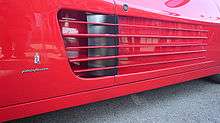
Pininfarina's body was a departure from the curvaceous boxer—one which caused some controversy.[7] The side strakes sometimes referred to as "cheese graters"[7] or "egg slicers,"[8] that spanned from the doors to the rear fenders were needed for rules in several countries outlawing large openings on cars. The Testarossa had twin radiators in the back with the engine instead of a single radiator up-front.[7] In conjunction the strakes provided cool air to the rear-mounted side radiators, thus keeping the engine from overheating. The strakes also made the Testarossa wider at the rear than in the front, thus increasing stability and handling.[3]
One last unique addition to the new design was a single high mounted side view mirror on the driver's side. On US based cars, the mirror was lowered to a more normal placement in 1987 and quickly joined by a passenger side view mirror for the driver to be able to make safe easy lane changes.
Like its predecessor, the Testarossa used double wishbone front and rear suspension systems. Ferrari improved traction by adding 10-inch-wide alloy rear wheels. The Testarossa drivetrain was also an evolution of the BB 512i. Its engine used near identical displacement and compression ratio, but unlike the BB 512i had four-valve cylinder heads that were finished in red.[7]
Testarossa
| Testarossa | |
|---|---|
_(cropped).jpg) Ferrari Testarossa (French spec) | |
| Overview | |
| Production | 1984–1991 (7,177 produced)[2][4] |
| Assembly | Maranello, Italy |
| Powertrain | |
| Engine | 4.9 L Tipo F113 F12[4][9] |
| Dimensions | |
| Wheelbase | 2,550 mm (100.4 in)[4] |
| Length | 4,485 mm (176.6 in)[4] |
| Width | 1,976 mm (77.8 in)[4] |
| Height | 1,130 mm (44.5 in)[4] |
| Curb weight | 1,708.2 kg (3,766 lb)[10] |
| Chronology | |
| Predecessor | Ferrari BB 512i |
| Successor | 512TR |
Engine
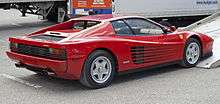
The Testarossa has a naturally aspirated 4,943 cc (4.9 L; 301.6 cu in) longitudinally-mounted, rear mid-engine, rear-wheel-drive layout 180° flat-12.[4][11], DOHC 4 valves per cylinder (48 valves in total), lubricated via a dry sump system, compression ratio of 9.20:1.[4][11] These combine to provide a maximum power of 287 kW (390 PS; 385 hp) at 6,300 rpm and maximum torque of 490 N⋅m (361 lb⋅ft) at 4,500 rpm.[2][4][12] Early U.S. versions of the car had the same engine, but had slightly less power, with only 283 kW (385 PS; 380 hp).[3][7][12]
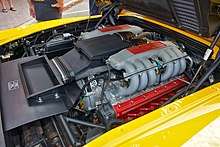
The Ferrari Testarossa can accelerate from 0–100 km/h (62 mph) in 5.3 seconds[2] and from 0–60 mph (97 km/h) in 5.2 seconds and on to 100 mph (161 km/h) in 11.4 seconds[2] (though Motor Trend Magazine managed 5.29 seconds and 11.3 seconds, respectively).[3] It can complete a standing (from stationary) quarter mile ~1⁄4 mi (402 m) in 13.5 seconds and a standing kilometre in 23.8 seconds.[2] The top speed of the Testarossa is 290 km/h (180 mph).[11]
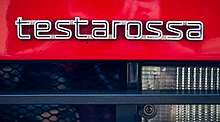
| Gear | Reverse | 1 | 2 | 3 | 4 | 5 | Final Drive |
|---|---|---|---|---|---|---|---|
| Ratio[2][12] | 2.523:1 | 3.139:1 | 2.104:1 | 1.526:1 | 1.167:1 | 0.875:1 | 3.210:1 |
Wheels and suspension
When introduced for the 1985 model year, the Testarossa had magnesium single bolt "knockoff" wheels with a 16.33 in (415 mm) diameter. These wheels used the Michelin TRX system, and the odd diameter size makes it impossible to fit standard tires. These wheels could only be fitted with TRX tires size 240/45 VR 415 for the front and TRX 280/45 VR 415 for the rear.
Starting sometime in the 1986 model year, the wheels kept the same design but were changed to a standard 16 in (406 mm)diameter, with a width of 8 in at the front and 10 in at the rear.[12] Goodyear Gatorback 225/50 VR 16 front tires and 255/50 VR 16 rear tires were fitted.[2][12] However, for the US market the cars were delivered with the metric sized TRX wheels until sometime 1989.
The original rear suspension consisted of independent, unequal-length wishbones, coil springs, twin telescopic shock absorbers on each side, and an anti-roll bar. The entire drivetrain and suspension was designed to be removed as a unit from underneath the car so the engine timing belts could be serviced.
In the 1988.5 model, the suspension was redesigned and the wheels were changed again from the single bolt knockoff setup to the standard Ferrari five bolt pattern. The wheel design still resembled the ones installed at the Testarossa's debut.[12]
The front brakes have a diameter of 309 mm (12.17 in) and the rear brakes have a diameter of 310 mm (12.20 in).[2]
Reception
The car had many admirers - it was featured on the cover of Road & Track magazine nine times in just five years. It lost comparison tests to Lamborghini Countach, Alpina B10 Bi-Turbo and BMW M5. The price of the Testarossa in the US was $181,000 in 1989, including a $2,700 "gas-guzzler" tax. The original selling price in the UK was £62,666.[13][14][15][16]
Well-known Testarossa owners included Jordan Belfort, Elton John, Marti Pellow, Alain Delon, O.J. Simpson, Rod Stewart, Michael Jordan, Mike Tyson, John Carmack, Dr. Dre, Suge Knight, Austrian Formula One racing driver Gerhard Berger, and Gary Monsieur. Don Johnson, who famously drove a white Testarossa on Miami Vice, was gifted a brand-new silver 1989 Testarossa by Enzo Ferrari himself, who was a fan of Miami Vice. Michael Mann, executive producer of the series, also had a custom painted, blue metallic Testarossa.[17]
Jack Nerad of Driving Today states, the Testarossa "... [was] a car designed and built to cash in on an image. And since cashing in was what the Eighties were all about, it was the perfect vehicle for its time. The saving grace was, it was also a damn good automobile."[7]
Although successful on the road, the Testarossa did not participate in racing series, unlike the BB 512i, which had done so with minor success.
As Ferrari's range-topper during the 1980s, the car made numerous appearances in pop culture, most notably in the arcade game OutRun, and in the third, fourth, and fifth seasons of Miami Vice. The car has subsequently become synonymous with 1980s "yuppies" and is an icon of 1980s retro culture.[18] Its signature side strakes have become a popular aftermarket body component for wide arch aesthetic body kits.[3] The side strakes also spawned body kits that were designed for cars such as the Pontiac Fiero and the Mazda B-Series pickup trucks (these were referred to as "Truxtarossa" kits), in addition to a wide variety of Japanese and American sports cars and motorcycles such as the Honda VFR.[7]
- Ferrari Testarossa white and interior dash
.jpg)
.jpg)
.jpg)
Testarossa Spider
The Testarossa Spider, serial number 62897, is the sole official convertible variant of the Testarossa commissioned in 1986 by the then Fiat chairman Gianni Agnelli to commemorate his 20 years of chairmanship of the company.[19] The Testarossa Spider had an Argento Nurburgring exterior, a white magnolia leather interior with a dark blue stripe running above the matte black sills, and a white electronically operated soft top that could be manually stowed away. The vehicle was delivered to Agnelli in four months, and had a solid silver metal Ferrari logo on the hood instead of an aluminium one. The silver theme refers to elemental silver's periodic table abbreviation, Ag, the first two letters of Agnelli's name.[19]
Many customers requested their own Testarossa Spider, but Ferrari declined every single one of them for spatial and structural challenges that would be difficult to resolve,[20] and so Pininfarina and other after market firms such as Pavesi, Lorentz and Rankel and Koenig Specials had to make unofficial Spider conversions on special consumer requests.[21] The official Spider was no different mechanically than the normal Testarossas available in the European market. It had a standard 4.9 L flat-12 engine producing 291 kW (396 PS; 390 hp), though the top speed was reduced because of the excessive weight arising due to the reinforced chassis. The only differences, other than being a convertible, were that the Spider's front window and door windows were both shorter than those of the normal car and the spider had a Valeo transmission installed which is convertible to both automatic and the standard 5-speed manual versions with the push of a button, a technology ahead of its time. The transmission was installed on special request of Agnelli as he suffered from a chronic leg injury.
A red Testarossa Spider famously featured in SEGA's best-selling arcade and home-console video-game franchise Out Run from 1986 onwards.[22]
The original car owned by Agnelli's family friend was auctioned off in 2016 at a price of US$1 million.[19]
512 TR
| 512 TR | |
|---|---|
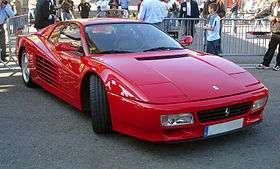 | |
| Overview | |
| Production | 1991–1994 (2,261 produced)[23] |
| Assembly | Maranello, Italy |
| Powertrain | |
| Engine | 4.9 L Tipo F113 D F12 319 kW (428 hp)[23][24] |
| Dimensions | |
| Wheelbase | 2,550 mm (100.4 in) |
| Length | 4,480 mm (176.4 in) |
| Width | 1,976 mm (77.8 in) |
| Height | 1,135 mm (44.7 in) |
| Curb weight | 1,656 kg (3,650 lb)[25] |
| Chronology | |
| Predecessor | Ferrari Testarossa |
| Successor | Ferrari F512 M |
Engine
The 512 TR sports a 4.9-litre (4,943 cc or 301.6 cu in) Ferrari flat-12 engine longitudinally mid mounted.[5][23] Each cylinder has four valves, with forty-eight valves total, lubricated via a dry sump system, and a compression ratio of 10.00:1.[5][24][26] These combine to provide a maximum torque of 491 N⋅m (362 ft⋅lbf) at 5,500 rpm and a maximum power of 319 kW (434 PS; 428 hp) at 6,750 rpm.[23][24][26]
The car can accelerate from 0–100 km/h (62 mph) in 4.80 seconds[27] and on to 161 km/h (100 mph) in 10.70 seconds.[5] It can complete a standing (from stationary) quarter mile in 13.20 seconds or a standing kilometre in 23.40 seconds.[5] The 512 TR has a top speed of 313.8 km/h (195 mph).[5][24][27]
| Gear | Reverse | 1 | 2 | 3 | 4 | 5 | Final Drive |
|---|---|---|---|---|---|---|---|
| Ratio[5][26] | 2.428:1 | 2.916:1 | 1.882:1 | 1.421:1 | 1.087:1 | 0.815:1 | 3.45:1 |
A recall was issued in 1995, regarding fuel hose fitting issues.[28] Over 400 models had this defect which was caused by variances in temperature and environment. Another recall was issued in relation to the passive restraint system on seat belts not functioning properly, on over 2,000 512TR's.[28] If the restraint system suffered a mechanical or electrical failure only the lap belt would provide safety to the occupant.
The 512 TR's engine was extensively reworked. Nikasil liners were added, along with a new air intake system, Bosch engine management system, larger intake valves, and a revised exhaust system. In addition to the higher peak power, the modifications delivered a more broad power curve for better acceleration.
Gearshifting effort, a prolonged complaint about the Testarossa, was eased with a new single-plate clutch, sliding ball bearings, and better angle for the gearshift knob. The braking system included larger cross-drilled front rotors. Quicker steering, lower-profile tires, and new shock settings improved handling. Most importantly, engine and gearbox position was rethought, which improved the centre of gravity, aiding the handling and making the car easier to drive.
The interior also received updates, with the centre console split from the dashboard, and the climate controls relocated. Pininfarina tweaked the body of the car for better integration of the newly included spoilers and the new engine cover and updated the design in line with the recently released Ferrari 348.
The 512 TR cost US$212,160 in the United States in 1992 with luxury items, the "gas-guzzler" taxes, and destination freight, and cost £131,600 in the UK.
Wheels
The 512 TR has 18 in (457 mm) wheels with a width of 8 in (200 mm) at the front and 10.5 in (270 mm) at the rear. The tire code for the front wheels are 235/40 ZR 18 and 295/35 ZR 18 for the rear tires.[5][24][26] The front brakes have a diameter of 315 mm (12.40 in) and the rear brakes have a diameter of 310 mm (12.20 in).[5]
F512 M
| F512 M | |
|---|---|
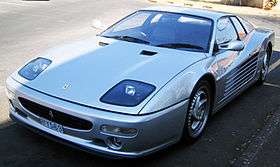 | |
| Overview | |
| Production | 1994–1996 (501 produced)[3][29] |
| Powertrain | |
| Engine | 4.9 L Tipo F113 G Flat-12[6][30] |
| Dimensions | |
| Wheelbase | 2,550 mm (100.4 in)[6] |
| Length | 4,480 mm (176.4 in)[6] |
| Width | 1,976 mm (77.8 in)[6] |
| Height | 1,135 mm (44.7 in)[6] |
| Curb weight | 1,455 kg (3,207.7 lb)[6] |
| Chronology | |
| Predecessor | Ferrari 512 TR |
| Successor | Ferrari 550 Maranello |
The F512 M was the last version of the Testarossa. 501 cars were produced in total, of which 75 were right hand drive. In 1995, the F512 M retailed for $220,000 (£136,500).[31]
Engine
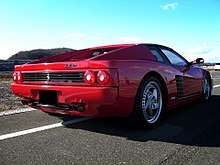
The F512 M sports a 4.9-litre (4,943 cc or 301.6 cu in) Tipo F113 G Ferrari flat-12 engine longitudinally mid mounted.[4][30] This provides a maximum torque of 500 newton metres (370 ft⋅lbf) at 5,500 rpm and a maximum power of 328.1 kW (446.1 PS; 440.0 hp) at 6,750 rpm.[6][30] Each cylinder has four valves, for forty-eight valves total, lubricated via a dry sump system, with a compression ratio of 10.40:1.[6][30] Due to new titanium connecting rods and a new crankshaft that together weigh 7.26 kilograms (16.0 lb) less than those that they replace, the engine has a 7,500 rpm electronic rev limit.[31]
The Ferrari F512 M can accelerate from 0 to 100 km/h (62 mph) in 4.70 seconds,[31][30] on to 161 km/h (100 mph) in 10.20 seconds,[6] and it can complete a standing quarter mile in 12.70 seconds or a standing kilometre in 22.70 seconds.[6] The F512 M has a top speed of 315 km/h (196 mph).[6][29][30]
| Gear | Final Drive |
|---|---|
| Ratio[6] | 3.31:1 |
Exterior
The front and rear lamps received a design change. The pop-up headlamps were replaced by two fixed square units.[31] The rear taillamps were round and the bumpers had been restyled to yield a more unified look.[31] This car featured a different front lid with twin NACA ducts.
Interior
The F512 M's interior received a minor update from the 512 TR. The gearshift knob had a chromed finish, the aluminum pedals were drilled, and air conditioning was now included as standard. Carbon fibre racing bucket seats were also available at no extra cost, weighing only 14.97 kg (33.0 lb); much less than the standard seats.[31] Pininfarina and Ferrari flags line the dash board.
Wheels
The F512 M has 18 in (457 mm) wheels with a width of 8 in (200 mm) for front and 10.5 in (270 mm) for the rears. The tires are Pirelli P Zero,[31][6] with codes for the front wheels of 235/40 ZR 18 and 295/35 ZR 18 for the rear tires.[30] The front brakes have a diameter of 315 mm (12.4 in) and the rear brakes have a diameter of 310 mm (12.2 in).[6]
Concept cars and coachbuilt derivatives
Mythos
The Ferrari Mythos is a mid-engined, rear wheel drive concept car based on the mechanical underpinnings of the Ferrari Testarossa. The Mythos is powered by a 4.9 L Tipo F113 B Ferrari flat-12 engine sourced from the Ferrari Testarossa, the engine produces 390 hp (291 kW; 395 PS) at 6,300 rpm and 354 N⋅m (261 lb⋅ft) of torque at 4,500 rpm while having a power to weight ratio of 308 hp (230 kW) per tonne. Power is sent to the rear wheels through a Testarossa sourced 5-speed manual transmission. The car utilises a helical coil suspension system with transverse arms on the front and rear. Acceleration figures of the car remain unknown, but the car has a projected top speed of about 180 mph (290 km/h).
Colani Ferrari Testa d'Oro
Designed by Luigi Colani in 1989, the Testa d'Oro was designed to break land speed records at the salt flats. It was based on a Testarossa with a turbocharged flat-12 engine featuring a 5.0 L Ferrari-Lotec turbocharger. The engine had a power output of 750 hp (559 kW) at 6,400 rpm and 900 N⋅m (660 lb⋅ft) of torque at 5,000 rpm. It successfully broke the record in its class in 1991, reaching 351 km/h (218 mph) with catalytic converters fitted.[32]
FX
.jpg)
The Ferrari FX was a one-off sports car custom made for the 29th Sultan of Brunei by Pininfarina.[33] It featured the flat-twelve engine of the Ferrari Testarossa and a 7-speed sequential manual transmission from the Williams Formula One team.[33] Only nine cars were ever made, six of which were delivered to the Royal Family in Brunei.[33] After the Sultan cancelled delivery of car number four, Dick Marconi bought the car from Williams.[33] Car number four is now on display at the Marconi Automotive Museum in Tustin, California.[33][34] The FX has a top speed of around 205 mph (330 km/h),[33] yet Ferrari claimed "We don't want to make the fastest car in the world".[35]
FZ93
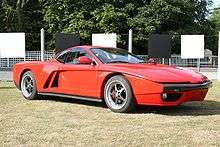
The FZ93 (Formula Zagato '93) was designed by Ercole Spada as a follow up to Zagato's series of Ferrari specials.[36] In 1994 the car was reworked and repainted all-red; it was also renamed as ES1 in honour of its designer.
F90
After almost 18 years, Ferrari acknowledged that the F90 existed and six were made for the Sultan of Brunei in 1988. A brief passage in the 2005 Ferrari Annual outlined an impressive order of six bespoke supercars which were much more daring than anything Ferrari would have produced themselves.
The project was managed by Enrico Fumia, the head of the Research and Development department at Pininfarina. At the time, the project was top secret to that extent that Ferrari themselves didn't know of the project. Fumia styled the car and said the F90 name referred to it being a "Ferrari of the '90s."
All six F90s used a Ferrari Testarossa chassis which Pininfarina used to sculpt an entirely new body and interior on top of. The engines were stock units, producing 390 hp (291 kW; 395 PS) and having a rear-wheel drive layout, but the radiators were moved to the front of the car.[37][38]
Notes
- ↑ "Jaroslaw Borzdynski's interview with Enrico Fumia". bozhdynsky.com. 2012.
- 1 2 3 4 5 6 7 8 9 10 "Carfolio: Ferrari Testarossa". Carfolio. Retrieved 2009-01-02.
- 1 2 3 4 5 6 7 8 9 Auto Editors of Consumer Guide. "Ferrari Testarossa". How Stuff Works. Retrieved 2009-01-03.
- 1 2 3 4 5 6 7 8 9 10 11 12 Melissen, Wouter (2004-12-01). "1984-1991 Ferrari Testarossa". Ultimate car page. Retrieved 2009-01-02.
- 1 2 3 4 5 6 7 8 9 "Carfolio: Ferrari 512 TR". Carfolio. Retrieved 2009-01-03.
- 1 2 3 4 5 6 7 8 9 10 11 12 13 14 15 "Carfolio: Ferrari F512 M". Carfolio. Retrieved 2009-01-03.
- 1 2 3 4 5 6 7 8 9 10 11 12 Nerad, Jack. "Ferrari Testarossa". Driving Today. Archived from the original on 2009-05-11. Retrieved 2009-01-02.
- ↑ Frank, Michael (2006-06-04). "Elton John's 'Red Devil' Ferrari Testarossa". Forbes. Retrieved 2009-04-30.
- ↑ "Ferrari Testarossa engine code". Retrieved 2017-12-15.
- ↑ "Car and Driver Ferrari Testerossa" (PDF).
- 1 2 3 "Ferrari World: Testarossa". Ferrari. Archived from the original (Flash) on December 8, 2008. Retrieved 2009-01-04.
- 1 2 3 4 5 6 "Testarossa Specifications". Red-headed.com. Archived from the original on 2009-05-07. Retrieved 2009-01-04.
- ↑ Car April 1986
- ↑ Sport Auto 1/1990
- ↑ Car April 1990
- ↑ 1989 Road and Driver, Exotic Edition.
- ↑ "Director Michael Mann Boxed Up His Blue Ferrari Testarossa For 18 Years". carbuzz.com. 2017-07-18. Retrieved 2018-08-07.
- ↑ Biggs, Henry (2006-03-06). "Top 10 Iconic 80s cars". MSN Cars UK. Retrieved 2009-01-04.
- 1 2 3 "Ferrari Testarossa Spider, a novelty". 2017-05-31. Retrieved 2018-01-12.
- ↑ "1986 Ferrari Testarossa Spyder | Reviews and Buyer's Guides | Sports Car Market - May 2004 issue". Sports Car Market. Retrieved 2010-05-15.
- ↑ "More Testarossa spiders in existence". Retrieved 2018-01-12.
- ↑ Out Run, 1987 UK instruction manual: "Your Car: Ferrari Testarossa Convertible. 2 door, 5 speed"
- 1 2 3 4 Melissen, Wouter (2004-12-01). "Ferrari 512TR". Ultimate Car Pages. Retrieved 2009-01-04.
- 1 2 3 4 5 "Ferrari World: 512 TR". Ferrari. Archived from the original (Flash) on December 8, 2008. Retrieved 2009-01-04.
- ↑ "Motortrend FERRARI TESTAROSSA VS. LAMBORGHINI COUNTACH".
- 1 2 3 4 "512 TR Specifications". Red-headed.com. Archived from the original on 2009-05-07. Retrieved 2009-01-04.
- 1 2 "Ferrari 512 TR". Ferrari GT - en-EN. Retrieved 2016-01-15.
- 1 2 "1993 FERRARI 512 TR". US National Highway Traffic Safety Administration recall no. 94V131000. CarFax. Archived from the original on 2008-09-07. Retrieved 2009-01-03.
- 1 2 Melissen, Wouter (2005-01-01). "Ferrari F512 M". Ultimate Car Pages. Retrieved 2009-01-04.
- 1 2 3 4 5 6 7 "Ferrari World: F512 M". Ferrari. Archived from the original (Flash) on December 8, 2008. Retrieved 2009-01-04.
- 1 2 3 4 5 6 7 Perini, Giancarlo (January 1995). "Ferrari F512 M". Car & Driver: pgs. 128–130.
- ↑ Wallace, Nicholas (2015-06-18). "Ferrari Testa d'Oro". caranddriver. Retrieved 2018-01-11.
- 1 2 3 4 5 6 Owen, Richard. "1995 Ferrari FX". Supercars.net. Supercars.net Publishing. Retrieved 2012-07-21.
For reasons we don't know, number four of seven was still being finished at Williams when the Sultan stopped his influx of cars and anything else expensive.
External link in|work=(help) - ↑ "1996 Ferrari FX". Marconi Automotive Museum. Tustin, CA USA. 2010. Retrieved 2012-07-21. External link in
|work=(help) - ↑ "Ferrari FX, Lamborghini Murciélago, and Maserati Spyder". Car and Driver. Retrieved 11 March 2015.
- ↑ "Ferrari FZ93". Supercars.net. 2004-03-01. Retrieved 2010-05-15.
- ↑ "supercars.net". Retrieved 2012-03-23.
- ↑ "fumiadesign.com" (PDF). Retrieved 2012-03-23.
References
- Bob Johnson. "Ferrari Testarossa". Road and Track (June 1989): 64–69.
- Buckley, Martin; Rees, Chris (1998). World Encyclopedia of Cars. London: Anness Publishing. ISBN 1-84038-083-7.
- "Retail Prices, Import Cars," Automotive News, April 1986: page 53.
- William Jeanes. "Preview: Ferrari 512TR". Car and Driver (March 1992): 57–59.
- Sir Mix-A-Lot wrote the track Testarossa (on his 1992 album Mack Daddy) about his "jet black" 1987 Testarossa.
- French House/Electro artist Kavinsky has written several songs about the Testarossa, including "Testarossa Autodrive", which was remixed by SebastiAn. The Kavinsky character's back story is that he fatally crashed his Testarossa and came back from the dead to make music.
- The video and arcade game Outrun uses the Testarossa as the main car in the game avoiding traffic along the way taking different routes to the destination.
External links
| Wikimedia Commons has media related to Ferrari Testarossa. |
- Ferrari FX at the Marconi Automotive Museum article
- Official Ferrari website with information on the Testarossa
- Ferrari Testarossa at the Internet Movie Cars Database
« previous — Ferrari road car timeline, 1960s–1990s — next » | |||||||||||||||||||||||||||||||||||||||||
|---|---|---|---|---|---|---|---|---|---|---|---|---|---|---|---|---|---|---|---|---|---|---|---|---|---|---|---|---|---|---|---|---|---|---|---|---|---|---|---|---|---|
| Type | 1960s | 1970s | 1980s | 1990s | |||||||||||||||||||||||||||||||||||||
| 0 | 1 | 2 | 3 | 4 | 5 | 6 | 7 | 8 | 9 | 0 | 1 | 2 | 3 | 4 | 5 | 6 | 7 | 8 | 9 | 0 | 1 | 2 | 3 | 4 | 5 | 6 | 7 | 8 | 9 | 0 | 1 | 2 | 3 | 4 | 5 | 6 | 7 | 8 | 9 | ||
| 8 cylinder | Mid-engine berlinetta | 308 | 308 i | 308 QV | 328 | 348 | 360 | ||||||||||||||||||||||||||||||||||
| 208 | 208 Turbo | GTB/GTS Turbo | F355 | ||||||||||||||||||||||||||||||||||||||
| Mid-engine 2+2 | 308 GT4 | Mondial 8 | Mondial QV | Mondial 3.2 | Mondial t | ||||||||||||||||||||||||||||||||||||
| 208 GT4 | |||||||||||||||||||||||||||||||||||||||||
| 12 cylinder | Boxer berlinetta | 365 BB | 512 BB | 512i BB | Testarossa (F110) | 512TR | F512 M | ||||||||||||||||||||||||||||||||||
| Grand tourer | 250 | 275 | 365 GTB/4 "Daytona" |
550 Maranello | |||||||||||||||||||||||||||||||||||||
| America | 330 | 365 | |||||||||||||||||||||||||||||||||||||||
| 2+2 coupé | 250 GT/E | 330 GT 2+2 | 365 GT 2+2 | 365 GTC/4 |
365 GT4 2+2 | 400 | 400 i | 412 | 456 | 456M | |||||||||||||||||||||||||||||||
| Supercar | 250 GTO | 250 LM | 288 GTO |
F40 | F50 | ||||||||||||||||||||||||||||||||||||
| Sold under the Dino marque until 1976; see also Dino car timeline | |||||||||||||||||||||||||||||||||||||||||